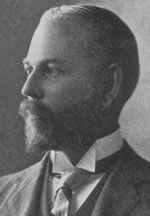
D. Sources of Influence and Transmission
10. Fenollosa, Ernest. Works 1896~1911.
Ernest Fenollosa’s importance to this study cannot be overstated. His manuscripts (see CB1) provide the material not only for Pound’s interest in and work with the nô (see especially BK24), but also Yeats’s (see especially BL11), along with Cathay (BK15), the ideogramic method (see especially BK32), and other material incorporated into The Cantos (BK31, 43, 72a). The reverberations from these have altered the course of poetry in English. In addition, Fenollosa’s studies of Japanese art have shaped Western understanding of the subject from his day to our own, overshadowing in influence even the work of Binyon, who himself relies instrumentally on Fenollosa. Certainly no Western poet drawing on Japanese art for subject, theme, or accoutrement in the years under study has been unaffected by the works noted below. Fenollosa’s general influence is discussed by Aiken (see BA), Binyon (BC21 and see below), Blunden (BD152), Ficke (BG5), Fletcher (BH4, 5, 13, 15, and see below), Lowell (BI16), Yeats (BL11, 15a), and of course Pound (BK9, 13, 13a-b, 17, 17a-b, 28, 40, 50, 51, 53, 54, 55, 59, 59a, c, e, g, h, 67, 68, 69, 71, 76b, c, e, 77e, 86, 87, 88a); for related discussion see also A18, 25, 27, 36, 46, 51, 54-56, 59, 60, 65, 70, 71, BC41, 43, BE5, BH25g, 29, BI10, BK22, 66, 89, 93a, d, g, 96, 102-06, 108, 110, 112, 114, 122, 126, 128, 131-33, 137, 139, 143-45, 150, 151, 153, 154, 160, 163, 165, 167, 169, 171, 173-75, 176a, 177, 178, 181, 187, 188, 191-93, 195, 201, 207, 209, BL85, 89, 92, 93, 95, 109, 116, 140, 161, 180, 180a3, 185, 191, 193, 205b, 214, 219, 234, 244, 256, CA9, CC2-3, 6, and D8.
a. The Masters of Ukiyoye. New York: Knickerbocker, 1896. Fenollosa’s catalogue for an ukiyoe exhibition in New York traces the historical development of the ‘genre school’ and far surpasses any study of the subject available in the West until Binyon’s Japanese Colour Prints (BC17) appeared twenty-seven years later. Hatcher (BC42) calls the work Fenollosa’s ‘masterpiece’ and notes that it is ‘that unlikeliest of literary genres, an exhibition catalogue that contrives to be a work of literature’. Binyon acknowledges the work in Colour Prints and elsewhere (BC6 and 14). Fenollosa’s later Outline History of Ukiyo-Ye (Tokyo: Kobayashi, 1901) is based on the catalogue.
b. ‘Notes on the Japanese Lyric Drama’. Journal of the American Oriental Society 22 (1901): 129-37. Fenollosa’s only work about the nô published in his lifetime surpasses in sympathy, authority, and completeness anything then available about the form in a European language, and establishes the central theses presented two years later in the manuscript that would become the source for Pound’s ‘Fenollosa on the Noh’ (BK13b). Fenollosa begins here by noting that the subject has been ‘touched upon briefly’ by Aston (see 13) and Chamberlain (see 5). Reprinted in BK201.
c. Epochs of Chinese and Japanese Art. 2 vols. New York: Stokes, 1911. Rev. ed., 1912. Fenollosa’s survey of the Chinese and Japanese art was prepared from his notes by his widow, Mary Fenollosa, who according to Hatcher had editorial help with the manuscript from Binyon. Fenollosa follows his student Okakura (see 16) in emphasising the importance of Zen Buddhism in Japanese art, and his account here becomes the acknowledged source of Fletcher’s understanding of the subject and the first attempt to incorporate Zen principles into English-language poetics (see BH4, BH4a-b).
d. Related materials. The fullest treatments in English of Fenollosa’s importance are Van Wyck Brooks, Fenollosa and His Circle (New York: Dutton, 1962) and Lawrence Chisolm, Fenollosa: The Far East and American Culture (New Haven: Yale UP, 1963), but the definitive work is Yamaguchi Seiichi, Fenollosa: Nippon bunka no senyô ni sasageta isshô (Fenollosa: A life devoted to the advocacy of Japanese culture, 2 vols., Tokyo: Sanseido, 1982). For evidence that Hirata Kiichi (Ap) was more responsible for the nô translations than has been noted in English, see also Furukawa Hisashi, ‘Fenollosa’s Letters’ (Comparative Studies of Culture 2 [Tokyo] [1956]: 99-110; 3 [1957]: 165-72).













